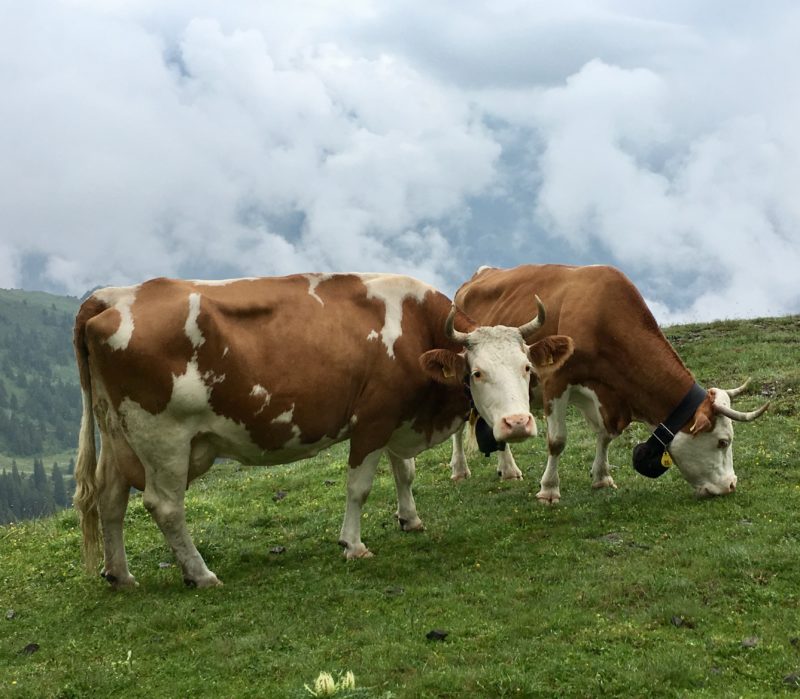Our food choices matter. This seems like an obvious statement: Choosing the cheeseburger with fries instead of that seasonal kale salad will probably impact your waistline more than the salad. But that choice has broader implications. You may not be aware, but your food choices can be a key contributor to climate change and have a negative impact on the environment.
Table of Contents
Your Diet’s Carbon Footprint
How do your food choices affect climate change? All our actions have a carbon footprint — a man-made mark, represented by the amount of greenhouse gases released into the atmosphere. All these accumulated GHG emissions contribute to trapping heat in the atmosphere, causing global warming.
When it comes to food, the carbon footprint for certain food products is sizable, and overall food production is responsible for approximately one-quarter of global GHG emissions. Not an insignificant amount.
In determining the environmental impact of various foods, you need to consider the GHG emissions generated across the many stages of food production:
- Land use (deforestation, water use, and changes in soil composition), which accounts for much of a food product’s GHG emissions.
- Animals vs plants vs seafood. The type of food (animal, plant, seafood), along with its living conditions and needs, result in varying emissions.
- Tools of production, such as farm machinery, fertilizers and pesticides, and processing into end products.
- Packaging, transportation, and preservation of the end product.
Which Foods Have the Biggest Environmental Impact?

In general, animal-based foods carry a higher carbon footprint than plant-based foods. Why? The short answer is that animal-based food production is incredibly resource-intensive. As you can see from this chart by Our World in Data, livestock depend on the two biggest impacts of a food product’s carbon footprint: land use (green) and farm-stage (brown) emissions.
And when it comes to comparing animal- and vegetable-based proteins, the environmental impacts of even the lowest-impact animal products exceed the average impacts of the vegetable-based proteins. According to a University of Chicago study, the GHG emissions of animal vs plant diets vary by as much “as the difference between owning an average sedan versus a sport-utility vehicle.”
It goes without saying that a shift away from animal-based foods towards a more plant-based diet can have a positive environmental impact. According to one study, for the U.S., where “per capita meat consumption is three times the global average, dietary change has the potential for a far greater effect on food’s different emissions, reducing them by 61% to 73%.”
How to Fight Climate Change With Your Food Choices

Now that you understand the link between food and climate change, what can you do? With simple lifestyle changes – some that you may already practice – it’s easy to reduce the carbon footprint of your food choices and make a positive environmental impact.
As you make your food selections, keep these general tips for climate-friendly food choices in mind. The good news is that a climate-friendly diet is one that’s also healthy for you.
- Eat less meat, particularly beef. If you’re not ready to give up meat, limit your consumption of carbon-intensive meats, such as beef. For any meat products, make sure they’re organic and free from hormones and antibiotics.
- Eat less dairy. Switch to plant-based alternatives that have a low footprint. Good options include coconut, hemp, pea protein, and oat.
- Eat more plants. Even if you’re not ready to go vegan, you can still make a positive impact by reducing your consumption of animal-based foods in favor of a plant-based diet. Focus on sourcing your protein from plants, including legumes and nuts.
- Sustainable seafood. Most seafood has a lower carbon footprint than meat, but some are more eco-friendly than others.
Resources
Use these resources to get you started with making climate-smart diet choices:
- BBC Climate Change Food Calculator helps you determine the climate impact of what you eat and drink by selecting from a group of food items. While not exhaustive in its options, it’s a good place to start for a general understanding of which foods are or aren’t climate-friendly.
- Food Carbon Emissions Calculator is a more wonky database, allowing you to set transport miles, amounts of food purchases, and waste percentages.
- The Vegan Society’s carbon food calculator lets you calculate the GHG emissions of your menu choices, taking into account every ingredient used.
- Nature Conservancy Carbon Footprint Calculator, includes a food footprint component to help you determine your average food footprint. It also provides general goals for improvement.
- The Seafood Carbon Emissions Tool displays carbon footprint information for seafood, fisheries, and aquaculture products.
- Fishwatch helps consumers make smart seafood choices with information about harvested and farmed U.S. fish.
- Seafood Watch offers recommendations to help consumers choose seafood that’s fished or farmed in ways that have less impact on the environment.
- Eat Low Carbon is a fun, but informative, interactive site that provides diet tips and food scores. There’s even a quiz to test your knowledge of which foods are planet friendlier.
Lifestyle Changes for a Climate-Friendly Diet

Eat Seasonally
Grabbing a container of strawberries in December seemed reasonable to me until I learned what’s involved with the production, packaging, and distribution of out-of-season products. All of these activities increase emissions. Instead, add seasonal foods to your diet, or opt for preserved (canned, frozen, dried) out-of-season items.
To help you with your seasonal picks, start with a visit to your local farmer’s market. In addition, these resources will help you make climate-friendly choices:
- Seasonal Food Guide has a terrific database that’s searchable by month, produce and state.
- USDA’s Seasonal Produce Guide groups fruits and vegetables by season. It also includes descriptions, nutritional content, and recipe ideas.
- GrowNYC for seasonal produce in the New York area.
Shop Sustainably
Minimize the carbon footprint of your food shopping trip by walking or biking to the store. As you head out the door, remember to bring your reusable bags and containers!
Shop and Eat Local

Although the environmental impact of food transportation is not as significant as other factors in food production, supporting your local businesses is a good thing. You’ll also make a dent in reducing the “food miles” associated with a particular food product.
Besides shopping local, try these additional ways to enjoy locally-grown food:
- Farmers’ Markets in your area. Check an online directory, such as Local Harvest, for locations near you.
- Community Supported Agriculture (CSA) networks that offer consumers regular deliveries of locally-grown farm products. Check the USDA CSA directory or Local Harvest organization’s CSA database for CSAs near you.
- Food establishments that support locally-sourced ingredients. To get you started, Eat Well Guide provides a directory of thousands of restaurants, farms, markets, and other sources of sustainable food throughout the U.S.
Purchase Less Processed, Packaged Foods
The production of processed, overly-packaged foods is more energy-intensive and generates a lot of unnecessary waste. Instead, enjoy meals made from natural, whole ingredients. It’s the healthier option, but you’ll also reduce your carbon footprint.
Grow Your Own Food
A perfect way to minimize your food’s carbon footprint is to start your own edible garden! Not only will you minimize packaging and processing, you’ll also control how your garden grows. Make sure to care for your new garden with natural techniques, using natural remedies for combating pests while feeding the soil and plants with natural fertilizers and soil amendments.
It’s Not Just About Food Choices …

Now that you’re making environmentally friendly food choices, don’t forget to dispose of any waste in a responsible manner. Food waste is a huge waste and an enormous contributor to climate change. In fact, if food waste was a country, it would be the third largest emitter of greenhouse gases. To make matters worse, a recent study reports that global food waste is twice as high as previously estimated.
How can you reduce this waste? There are a number of ways, which include planning ahead, using up leftovers, proper freezing and storage, and composting, instead of throwing out, unwanted food.
Speak Out With Your Voice and Your Wallet
You may think that one person has little ability to move the needle on climate change. It’s true, we need to make a change on a massive scale, but that collective effort can only be successful with individual lifestyle changes.
Start by choosing more climate-friendly dietary choices for your family, and then, if you’re ready to take the next step, take action on a broader scale by encouraging others to follow your lead.









